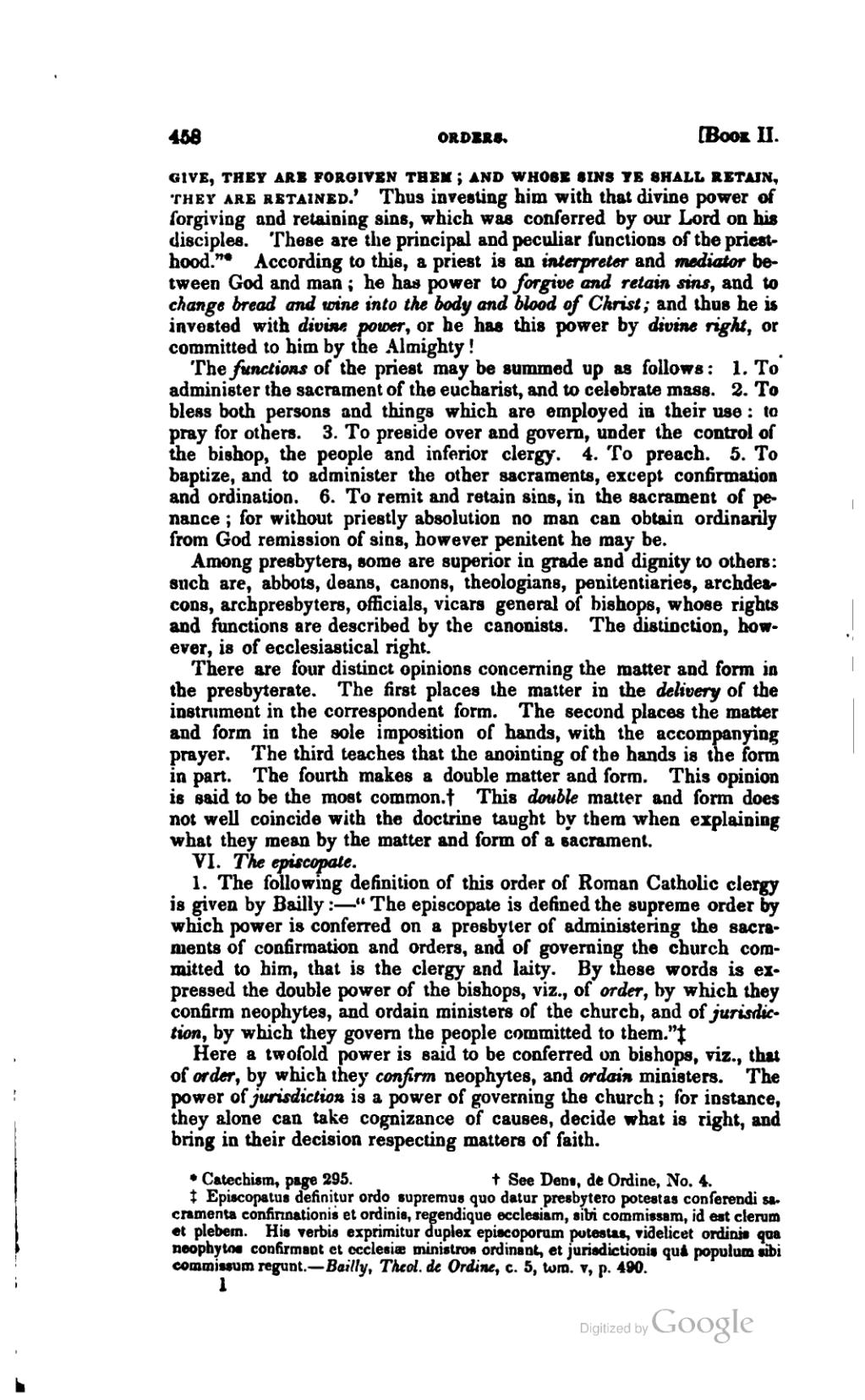4M oDu. ]3. GIVE, THEY ARB FOROIVEN THEIr; AND WH08B SZNS YE 8HALL RETAIN, THEY ARE RETAINED.' Thus investing him with that divine power of forgiving and retaining sins, which was conferred by our Lord on his disciplee. These are the principal and peculiar functions of the priest- hood."* According to this, a priest is tween (?od and man; he has power to d, ange bread and winz into the body and invested with divm,,, pou?r, or he has an intzrprztm- and m?/ator be- forgiv? and retain ?/n?, and ?o blood of Christ; and thus he is this power by d/vi?e r/gAt, or committed to him by the Almighty ! . 'rhe fs,w. tio;u of the priest may be summed up as follows: 1. To administer the sacrament of the eucharist, and to celebrate mass. 2. To bless both persons and things which are employed iu their use: to pray for others. 3. To preside over and govern, under the control of the bishop, the people and inferior clergy'. 4. To preach. 5. To baptize, and to administer the other sacraments, except confirmation and ordination. 6. To remit and retain sins, in the sacrament of pe- nance; for without priestly absolution no man can obtain ordinarily from God remission of sins, however penitent he may be. Among presbyters, some are superior in grade and dignity to others: such are, abbots, deans, canons, theologians, penitentiaries, archdea- cons, archpresbyters, officials, vicars general of bishops, whose rights and functions are described by the canonists. The distinction, how- ever, is of ecclesiastical right. There are four distinct opinions concerning the matter and form in the presbyterate. The first places the matter in the delivery of the instrument in the correspondent form. The second places the matter and form in the sole imposition of hands, with the accompanying .prayer. The third teaches that the anointing of the hands is the form in part. The fourth makes a double matter and form. This opinion is said to be the most common.? This doub/e matter and form does not well coincide with the doctrine taught by them when explaining what they mean by the matter and form of a sacrament. VI. The e/?copate. 1. The following definition of this order of Roman Catholic clergy is given by EaSily :--" The episcopate is defined the supreme order by which power is conferred on a presbyter of administering the sacra- ments of confirmation and orders, and of governing the church com- mitted to him, that is the clergy and laity. By these words is ex- pressed the double power of the bishops, viz., of order, by which they confirm neophytes, and ordain ministers of the church, and ofjur/sd/c- t/on, by which they govern the people committed to them."? Here a twofold power is said to be conferred on bishops, viz., that of ?der, by which they conJ?rm neophytes, and orda/,? ministers. The power ofjurisdictio? is a power of governing the church; for instance, they alone can take cognizance of causes, decide what is right, and bring in their decision respecting matters of faith.
- Catechism, page 295. t See Dens, de Ordine, No. 4.
- ? Episcopatus definitur ordo supremus quo datur presbytero peteetas conferendS
cramenta confinn&tioni? et oralisis, regendiciue ecclesiarn, sibi commiesare, id eat clerum piebern. H. is verbis exp.rimitu, .clu. piex ep'?oporum po.?.tu, ,iaeUcet o? qua neopn.ytM con?trmant et ccctesim ministree ordinsnt, et jurisdictionS, qui populum sibi coreminsure regunt.?Bo?!l]l, T/ted. d? Ordi?de, c. 5, tom. v, p. 490. !
�
